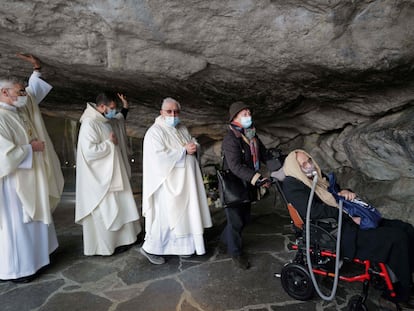Miracle in Missouri? The case of the supposedly incorrupt nun that attracts thousands in the US
The exhumation of the remains of the founder of a Benedictine order has unleashed religious fervor in a country where Catholics are a minority. Forensic experts state that the failure of a corpse to decompose after four years is more common than it seems
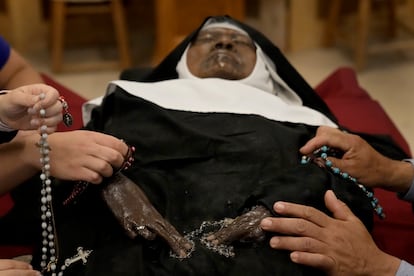

Sister Mary Wilhelmina Lancaster had lived a religious life for half a century when she found herself disillusioned. The direction the customs in the Catholic Church and in her congregation of Black nuns in Baltimore were taking was “too progressive,” to her mind, so in the mid-1990s she founded a Benedictine order dedicated to Latin mass and Gregorian chant. She was 70 years old. A decade later, the diocese of Kansas City gave her a plot of land about 43 miles north of the city, to build an abbey near Gower, Missouri. In 2019, at the age of 95, she died at her abbey, surrounded by fifty nuns from the congregation.
Last May, when they went to exhume her remains to transfer them from her tomb to the church altar, they discovered a supposed miracle: four years later, the body was apparently incorrupt. According to forensic science, however, is not as unusual as it may seem. “When we unearthed it, the coffin had a crack, through which the abbess and I could see one of the feet was still intact. Also surprising was the pristine state of the habit, when the lining of the coffin had disintegrated. We interpret it as a message from God: he wants Wilhelmina to continue with her religious work,” Sister Scholastica, prioress of the abbey, recalled last Sunday before mass, who asserted that the body had not been embalmed before its burial.
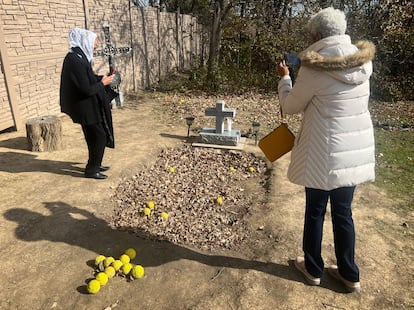
She also said that they had no intention of making the discovery public, but that carelessness on their part using email caused the news to spread “like a wildfire” throughout Missouri. First it was the local news, then the national media. And there was no one to stop it. Since the exhumation, the prioress estimates that “tens of thousands of people” have come, “[from] as far as the Philippines, to see Sister Wilhelmina with their own eyes.” The high point came at the end of the summer, during the long weekend around Memorial Day. Sister Scholastica says that the abbey received “about 50,000 visitors.” That’s not easy to believe either: the only access to the remote abbey is via an unpaved track, and in order to face the new logistical challenges, the nuns have had to convert an alfalfa field into extra parking.
It may have been influenced by the fact that those were the last days in which the body was displayed in the middle of the abbey, and people could touch it, before it was transferred to the glass sarcophagus it now occupies. From then on, the flow of visitors has been more easily managed. Last Sunday, about 150 people showed up for the 11:00 mass and filled the abbey church. In any case, it was a much higher number than before the commotion caused by the discovery, as confirmed by parishioner Anna Vogel, pregnant with her “fourteenth child.”
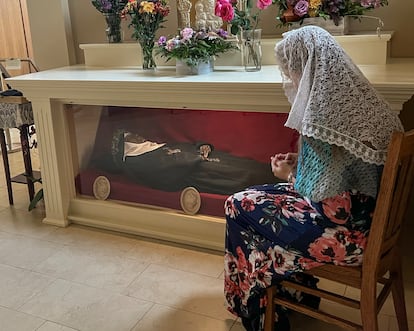
The prioress says that since the body was exhumed, “about 50 miracles” have occurred and that they have observed “an even greater growth than before in the number of vocations” — to absorb them, she says, they are building another abbey to the south, on the border with Arkansas. The nun describes cases of cures for heart ailments, cancers going into remission, and the case of a boy who “had not been able to move his neck for years and the problem was fixed after placing it on Sister Wilhelmina’s body. We are documenting them all, so that, when the time comes, we can pass all that information to the bishop.”
To open a cause for sainthood, the church requires that five years have passed since the person’s death (and no more than 50), so in this case there are still six months left. The person in charge of starting it is the diocese of Kansas City-Saint Joseph, to which the order belongs. Sister Scholastica explains that “normally things work the other way around”: first the case is opened and then the supposed miracles arrive. Also, she is “convinced” that the bishop, James Van Johnston Jr., “is eager to begin the process.”

The diocese spoke out last May, when the news broke, with a statement in which they asked for caution. “Understandably, the condition of Sister Wilhelmina Lancaster’s remains has generated interest and raised important questions. At the same time, it is essential to protect her integrity to allow a thorough investigation,” it said. A spokeswoman explained to EL PAÍS this Thursday that “there is no news about that text.” Convinced by Sister Scholastica, he responded: “It is not correct that any decision has been made about whether the bishop will pursue the process of sanctification. I cannot even confirm that after five years the case will be opened,” he added.
“There are people who see miracles everywhere, but I feel it. I don’t see anything unusual in the fact that a body is preserved in that state four and a half years after being buried,” Marin Pilloud said in a telephone conversation on Friday. The forensic anthropologist at the University of Reno, Nevada, continues: “There are many reasons that can contribute to slow decomposition: body mass index, contact with water, if the person was taking certain medications, or if the body was buried in especially cold ground. “You would be surprised how many strange things can happen after death.”
Fernando Serrulla, head of Forensic Anthropology at the Institute of Legal Medicine of Galicia, who has studied the remains of the apostle St James the Lesser, describes two possible processes. “On the one hand, there is saponification, which happens with bodies with an abundance of fat and in humid and cold environments. On the other hand, mummification occurs when the skin dries very quickly and remains like a kind of drum skin on the bones. That is more common in dry, hot environments, like ancient Egypt,” he explains. “We can’t offer a percentage that gives an idea of how common these processes are, because no one is spending time digging up entire cemeteries, but they certainly are common.”
The explanation that Serrulla offers for the nuns' surprise at the different decomposition of the tissues is also skeptical: “The fabrics used in the sarcophagi are usually biodegradable. I have unearthed bodies from the civil war with parts of their clothing intact. So nothing extraordinary, either.” Furthermore, an examination of photographs of Wilhelmina's body makes Serrulla suspect that perhaps the body underwent “some type of embalming.”
The complex path to holiness
Canonization is a complex procedure, in which faith obviously overrides any type of rational or scientific explanation, such as those offered by Pilloud or Serrulla. The diocese appoints an investigator, who spends time collecting evidence that, if the cause warrants it, is sent to the Vatican. If experts in Rome certify that the person in question has worked a miracle, they will be named blessed. If there are two miracles, a saint.
“There are processes, such as the recent ones of John Paul II and Teresa of Calcutta, that have been resolved by express means (for political reasons), but in general it is a long process, often lasting decades or centuries,” says Michael Heinlein, editor of the book Black Catholics on the Road to Sainthood (2020). In it he has collected the cases of the six African-Americans who are “on the road to sainthood.”
The devout and curious who flock to Gower do not seem willing to wait for things to become clearer. The mass last Sunday, which was said entirely in Latin (except for the sermon, in which the priest prayed that the vote that made the right to abortion constitutional last week in Ohio would not succeed — it was an unanswered prayer) was attended by people arriving from Kansas City and Arkansas. Also among the congregation were faithful who had arrived on a bus chartered by a woman named Ida R. Muorie. She had flown in from Orlando, Florida, and planned to continue working to “bring people and make this story known. I already have a waiting list of about 90 people. Something like this is what our Church, which has forgotten about saving souls to dedicate itself to politics, needs now,” she explained.

Muorie, like Wilhelmina and many of those present Sunday, is a kind of unicorn on the map of beliefs in this country: an African-American Catholic. Only 3%, according to the Pew Research Center, profess that faith. Most of the rest are evangelicals.
The African American Cause
That is why Wilhelmina’s case is so significant for Heinlein. ”I pray every day that one person from the African-American community will be sanctified, so that they can feel represented.” The book he wrote was, he says, his contribution to the cause. “For the miracles demanded by the Vatican to occur, people must pray to them, so I wanted to bring those six cases to the attention of the Catholics of this country,” he clarifies. If her cause ended up being opened, Wilhelmina would be the seventh on the list, and she would join Mother Mary Lange, founder of the first order of black nuns in the country “with the objective of educating and evangelizing African Americans.” It was Wilhelmina’s order for half a century, before she created her own, which has 52 nuns in Gower, of whom only one is black.
Javier López Goicoechea, professor of state ecclesial law at the Complutense University of Madrid and expert in canon law, adds perspective to the history of Missouri of the difficult relations between the Vatican and the American dioceses, which are “so conservative” and “many of them are bankrupt” by the cases of sexual abuse and “by evangelical expansion.” “In this context of infantilization of the faith, the certification of a miracle would be very convenient to counteract the attraction of other churches with more charismatic resources.”
López Goicoechea also recalls that religious orders have traditionally pushed for their founders, like Wilhelmina, “to be saints or blessed,” because “that brings an ecclesiastical character or cachet,” and that the fact that Gower’s Benedictines have opted for the mass in Latin might be a problem when it comes to winning Pope Francis’ support for the cause. In 2021, the Supreme Pontiff limited the practice of the Traditional mass in Latin to exceptional cases, turning his back on the faithful, which angered the most conservative wings of the Church. The prioress is proud that they are “the only Benedictines who officiate in this way in the English-speaking world.”
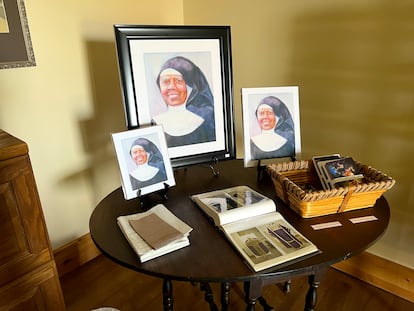
According to Heinlein, the first thing that is checked at the beginning of the canonization process is whether the person whose case is being examined has generated a popular cult. “And judging by the news, it seems that they have achieved that in Gower,” he says. Another requirement is that devotees be able to become familiar with the life of the candidate for sainthood. That matter is also covered: in the abbey’s gift shop, one of the star products is the lavishly illustrated biography of Wilhelmina, published as a tribute by the nuns in 2020 under the (unoriginal) title, God’s Will. In it they say that she was a woman who was fond of poetry, had a sense of humor, and had to overcome the obstacles of racism in the American Church during her long life.
Another of the store’s hits is the Gregorian chant (available to buy on CD) that the nuns recorded in 2008 and 2019. Perhaps that prepared them to manage the phenomenal attention from outside that they are now shamelessly receiving. The news that they topped the Billboard chart of best-selling religious albums for three years also then attracted reporters to this remote corner of Missouri.
Sign up for our weekly newsletter to get more English-language news coverage from EL PAÍS USA Edition
Tu suscripción se está usando en otro dispositivo
¿Quieres añadir otro usuario a tu suscripción?
Si continúas leyendo en este dispositivo, no se podrá leer en el otro.
FlechaTu suscripción se está usando en otro dispositivo y solo puedes acceder a EL PAÍS desde un dispositivo a la vez.
Si quieres compartir tu cuenta, cambia tu suscripción a la modalidad Premium, así podrás añadir otro usuario. Cada uno accederá con su propia cuenta de email, lo que os permitirá personalizar vuestra experiencia en EL PAÍS.
¿Tienes una suscripción de empresa? Accede aquí para contratar más cuentas.
En el caso de no saber quién está usando tu cuenta, te recomendamos cambiar tu contraseña aquí.
Si decides continuar compartiendo tu cuenta, este mensaje se mostrará en tu dispositivo y en el de la otra persona que está usando tu cuenta de forma indefinida, afectando a tu experiencia de lectura. Puedes consultar aquí los términos y condiciones de la suscripción digital.
More information
Archived In
Últimas noticias
Most viewed
- Sinaloa Cartel war is taking its toll on Los Chapitos
- Oona Chaplin: ‘I told James Cameron that I was living in a treehouse and starting a permaculture project with a friend’
- Reinhard Genzel, Nobel laureate in physics: ‘One-minute videos will never give you the truth’
- Why the price of coffee has skyrocketed: from Brazilian plantations to specialty coffee houses
- Silver prices are going crazy: This is what’s fueling the rally

